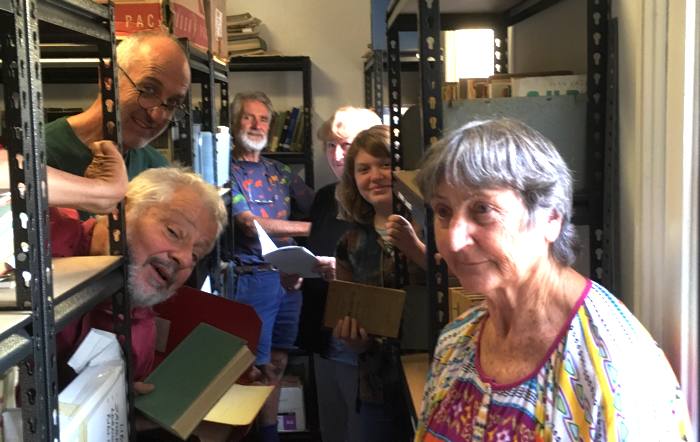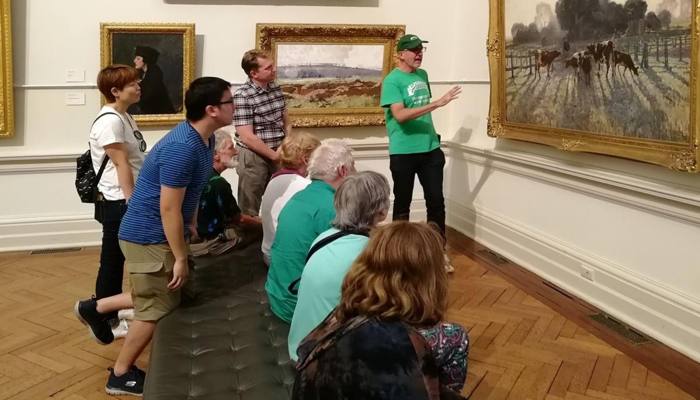By Terry Manley (Armidale, NSW)
(English translation of an article originally published in Esperanto sub la Suda Kruco, vol. 26[2], no. 135, June 2019)

I arrived at Esperanto House on Tuesday, 23 April, and met Franciska, who also came to help with the archive at Esperanto House. After a bit of a chat we went shopping and, returning to the club, had dinner. Dmitry had left a mattress and sheets for me on the upper floor where I slept. It was pleasing to hear Franciska’s fluent, clear voice and have a chance to talk [in Esperanto] face to face, which I miss in Armidale.
On Wednesday morning Sandor, Jonathan, and Heather with her granddaughter, Elizabeth, arrived. So there were six of us to fill the space and work on the archive. After a brief meeting… we started working. I write “started” but immediately there was hesitation, as we noted how much work we faced to classify, order, unbox, scan, record, etc, the contents of the room. But deciding that a journey of a thousand steps starts with the first, we started.
Heather and Franciska concentrated on putting the already numbered books in order onto the selves. And they continued doing this for three days, because there were so many books. I congratulate them for such diligent focus, without which the task would not have been completed. On the first day, Sandor and Jonathan explored boxes that contained Australian items, specifically photos. They also discussed the system of ordering books. Since others had already started with the Dewey system we agreed to continue likewise. There are both advantages and disadvantages with this system in the cases of specialist collections. The Esperanto collection is classified as if Esperanto were its own country, not as in a normal Australian library.
At 2:30pm we went to the state art gallery. Through Meetup Jonathan had organised to guide a group for one hour at 3pm. Our group and four others – James, Doris, Helen and Dmitry – met for the tour. Jonathan showed us some paintings from the collection and explained how you can see echoes of both shapes and colors in some paintings. He also showed us the use of the “golden ratio” by one painter. Five of us decided to stay on to look at some more paintings and to watch a film. The film was “A Touch of Zen” from Thailand, 1971.

On Thursday, Alan Turvey arrived at Esperanto House. Again, Heather, Franciska and I continued the shelving of the books, while Sandor, Alan and Jonathan photographed, digitised and recorded photos from the boxes. I feel that the work is a like a self-guided course, where we learnt about the Dewey system, how many books are involved in each category, and also how Esperantists have worked hard to create this literature, both original and translated, including specialist books. Some of us learnt how best to use a mobile phone to photograph things. We learnt about some treasures from our collection, first editions and rarities.
On Thursday evening four of us – Heather, Sandor, Franciska and I – went to meet [Esperanto speaker] Daniel Kane in Epping for dinner at a pizzeria. It was an evening of good-hearted chat, remembering the past and catching up.
On Friday six of us – Elizabeth, Heather’s granddaughter, had returned – worked on the archive. Up from the ground floor floated beautiful music from a Russian singing group, who had come to rehearse. Before starting we had the opportunity to visit the studio behind Esperanto House, and the artists who work in it. Hugh has leased the space from EFNSW (Esperanto Federation of NSW) since 1995 and has been successful enough to continue working there since. He has gathered a community of local artists and the atmosphere was vibrant and extremely interesting for us.
Then we managed to put nearly all the numbered books onto the shelves and do lots of photography. We also started to organise some Esperanto items such as those relating to UEA (World Esperanto Association): year books, congress books, etc. We want to acknowledge the work of those who had previously taken care of the archive. Ralph Harry, Peter Hai and Huigh Malcolm need special mentions. Many of the bound collections of newspapers are already on the shelves thanks to Huigh.
At 3pm we met together and showed each other what we had done individually and again summarised the group’s goals and discussed plans to continue the work. After 4pm many Russian children came to the club to paint and make other artefacts related to their culture. It was good to note that the club really lives through the extension to groups from other cultures. In the evening Franciska and I went to Newtown, where we ate in a Thai restaurant. By chance we bumped into Heather and Elizabeth on the street.
Early on Saturday, I went to Manly beach, where I enjoyed swimming in the clear, smooth waves. Later I met Roger Springer, Sandor and Franciska at the Bavarian Café. It was not a usual Saturday for that [Manly Esperanto Club], so we thank Roger for coming to meet us and for the drinks. Roger brought Eunice Graham’s photo albums to donate to the archive. Sandor and I said good-bye because we were going to a language festival in Gordon, which Dmitry had organised. It was a very friendly event with about 20 participants. We learned a bit about Tamil, Hindi, Arabic, Tangut (an ancient language near Mongolia), Dutch, and a language from a small group in Russia. Dmitry presented that last one. Also, Sandor introduced Esperanto.
Arriving at Esperanto House in Dmitry’s car, I was ready to rest, but the club was so active that this was not possible. In the courtyard was a group of actors and assistants who were making a movie in the artists’ studio. They ate and chatted. Dmitry, with a friend Sam, led a chess group on the upper floor. I looked in and there were 10–12 of them. In the room below Richard Delamore was teaching Esperanto to 12 young people. He entertained them with a lively lesson on the rules of the “good language”.
Feeling the need to wind down a little, I left the chess-lovers and young people to their activities. I walked with Sandor across the university grounds to the place where he was staying. It was more tranquil between the impressive sandstone buildings with their beautiful archways and courtyards, without the constant traffic going past.
Returning to the club I found it quiet. There was only a silent duo playing a final chess game.
Good night.
